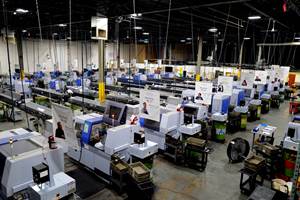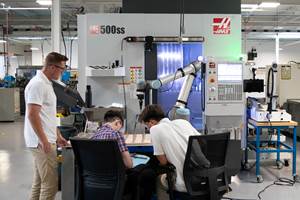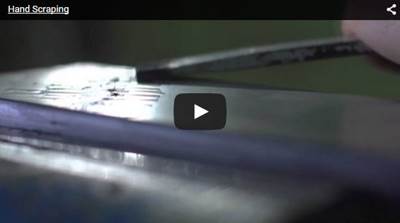The Art and Science of Hand-Scraping Ways on CNC Machine Tools
Hand-scraping the mating surfaces of a CNC machine tool’s motion system offers myriad advantages.
Share






In an age of computer numerical controls and automated processes, hand scraping mated surfaces on a machine tool might seem a bit antiquated. Many OEMs have abandoned it, in fact, pointing to the extra time and effort the operation requires. Some still stand by its value, however, claiming that the craftsmanship involved—and the benefits it provides—cannot be duplicated mechanically. So what is hand scraping, and is it a feature that buyers should seek out when considering the attributes of a new machine tool?
Hand scraping is a manual process of truing and providing texture to mated surfaces in a machine tool. It is most often performed using a flat scraper, which is a hand tool with a flat-edged tip similar to a wood-carving tool. The tip of the scraper is generally an inch wide or smaller, matching the width of the metal shaft—which can be of various lengths—for rigidity. The person performing the operation holds the tip of the scraper firmly against the surface to be worked with one hand while grasping the tool handle with the other, thrusting the tool against the surface with powerful strokes using the body’s weight in order to create a pattern. Other tools used for hand scraping include a three-corner scraper, which is often used to deburr holes, and a curved scraper that can treat the surface of bush bearings.
Understanding Hand Scraping
According to Okuma America Corporation—a longtime advocate for the process—the main reasons for hand scraping mated surfaces have to do with oil retention, stability and accuracy. Once the two castings have been joined, the upper piece is coated with engineer’s blue—the pigment Prussian blue in an oil base—and rested atop the way on which it will ride during operation. The resulting imprint reveals areas of contact, allowing the hand scraper to true the surfaces so that they are properly mated but also to create pockets or slight depressions in which oil can pool while its surface tension is retained. This enables a smooth, gliding movement and helps avoid the “slips and starts” caused by contact between perfectly flat surfaces from which lubricants tend to be squeezed. This causes the metal surfaces in contact with one another to grab and seize. The ideal, for most machine tool slideways, is to create approximately eight points of contact between the mated surfaces per square inch, providing flatness and stability and preventing rocking. Typically about six components within an average machine tool will have surfaces to which hand scraping can be applied.
The Difference Between Scraping and Machining
So, isn’t it possible for this manual surface-finishing procedure to be performed by a machine? Some OEMs do just that, machining oil grooves into flat surfaces, while others have transitioned completely to precision linear rails that can be mounted with screws and replaced when they become worn. There are also power tools that can be used to produce an oil-trapping surface texture. The obvious questions involve how machined channels affect surface integrity and whether accuracy is compromised toward the end of a linear rail’s service life. Lapping is sometimes used, but it tends to address the entire surface without creating the high contact points so useful in achieving stability, and it is not ideally suited for creating long, flat surfaces.
Probably the most convincing reason for seeking out hand-scraped mated surfaces in new machine tools involves the fact that the castings used in these applications are, by their very nature, somewhat irregular in their geometry. In addition, the grinding and machining methods used to simulate hand scraping can introduce contracting, flexing and expansion of material—and, later, distortion. So the logical conclusion here may be that the art of hand scraping still has a place in the science of building accurate, reliable, long-lasting machine tools.
Related Content
Inside the Premium Machine Shop Making Fasteners
AMPG can’t help but take risks — its management doesn’t know how to run machines. But these risks have enabled it to become a runaway success in its market.
Read MoreHow to Determine the Currently Active Work Offset Number
Determining the currently active work offset number is practical when the program zero point is changing between workpieces in a production run.
Read MoreCNC Machine Shop Honored for Automation, Machine Monitoring
From cobots to machine monitoring, this Top Shop honoree shows that machining technology is about more than the machine tool.
Read MoreThe Future of High Feed Milling in Modern Manufacturing
Achieve higher metal removal rates and enhanced predictability with ISCAR’s advanced high-feed milling tools — optimized for today’s competitive global market.
Read MoreRead Next
Secrets to the Art of Hand Scraping
Hand scraping of mating surfaces on a machine tool enables the surfaces to be flatter, more accurately aligned, longer wearing and freer to glide across one another. No automated or mechanical operation can match these benefits. Machine builder Okuma explains how this seeming paradox is true.
Read MoreAMRs Are Moving Into Manufacturing: 4 Considerations for Implementation
AMRs can provide a flexible, easy-to-use automation platform so long as manufacturers choose a suitable task and prepare their facilities.
Read MoreMachine Shop MBA
Making Chips and 91ÊÓƵÍøÕ¾ÎÛ are teaming up for a new podcast series called Machine Shop MBA—designed to help manufacturers measure their success against the industry’s best. Through the lens of the Top Shops benchmarking program, the series explores the KPIs that set high-performing shops apart, from machine utilization and first-pass yield to employee engagement and revenue per employee.
Read More




















